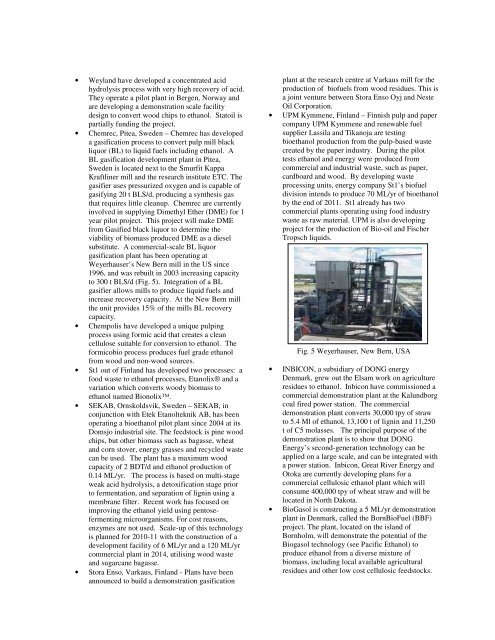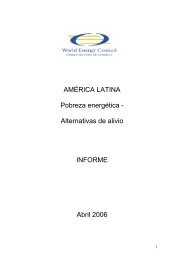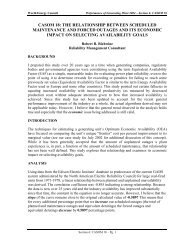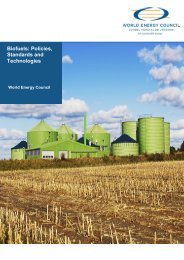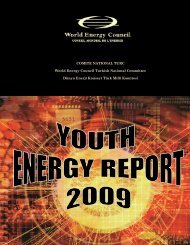Bioethanol – status report on bioethanol production from wood and ...
Bioethanol – status report on bioethanol production from wood and ...
Bioethanol – status report on bioethanol production from wood and ...
You also want an ePaper? Increase the reach of your titles
YUMPU automatically turns print PDFs into web optimized ePapers that Google loves.
• Weyl<strong>and</strong> have developed a c<strong>on</strong>centrated acid<br />
hydrolysis process with very high recovery of acid.<br />
They operate a pilot plant in Bergen, Norway <strong>and</strong><br />
are developing a dem<strong>on</strong>strati<strong>on</strong> scale facility<br />
design to c<strong>on</strong>vert <strong>wood</strong> chips to ethanol. Statoil is<br />
partially funding the project.<br />
• Chemrec, Pitea, Sweden <str<strong>on</strong>g>–</str<strong>on</strong>g> Chemrec has developed<br />
a gasificati<strong>on</strong> process to c<strong>on</strong>vert pulp mill black<br />
liquor (BL) to liquid fuels including ethanol. A<br />
BL gasificati<strong>on</strong> development plant in Pitea,<br />
Sweden is located next to the Smurfit Kappa<br />
Kraftliner mill <strong>and</strong> the research institute ETC. The<br />
gasifier uses pressurized oxygen <strong>and</strong> is capable of<br />
gasifying 20 t BLS/d, producing a synthesis gas<br />
that requires little cleanup. Chemrec are currently<br />
involved in supplying Dimethyl Ether (DME) for 1<br />
year pilot project. This project will make DME<br />
<strong>from</strong> Gasified black liquor to determine the<br />
viability of biomass produced DME as a diesel<br />
substitute. A commercial-scale BL liquor<br />
gasificati<strong>on</strong> plant has been operating at<br />
Weyerhauser’s New Bern mill in the US since<br />
1996, <strong>and</strong> was rebuilt in 2003 increasing capacity<br />
to 300 t BLS/d (Fig. 5). Integrati<strong>on</strong> of a BL<br />
gasifier allows mills to produce liquid fuels <strong>and</strong><br />
increase recovery capacity. At the New Bern mill<br />
the unit provides 15% of the mills BL recovery<br />
capacity.<br />
• Chempolis have developed a unique pulping<br />
process using formic acid that creates a clean<br />
cellulose suitable for c<strong>on</strong>versi<strong>on</strong> to ethanol. The<br />
formicobio process produces fuel grade ethanol<br />
<strong>from</strong> <strong>wood</strong> <strong>and</strong> n<strong>on</strong>-<strong>wood</strong> sources.<br />
• St1 out of Finl<strong>and</strong> has developed two processes: a<br />
food waste to ethanol processes, Etanolix® <strong>and</strong> a<br />
variati<strong>on</strong> which c<strong>on</strong>verts <strong>wood</strong>y biomass to<br />
ethanol named Bi<strong>on</strong>olix.<br />
• SEKAB, Ornskoldsvik, Sweden <str<strong>on</strong>g>–</str<strong>on</strong>g> SEKAB, in<br />
c<strong>on</strong>juncti<strong>on</strong> with Etek Etanolteknik AB, has been<br />
operating a <strong>bioethanol</strong> pilot plant since 2004 at its<br />
Domsjo industrial site. The feedstock is pine <strong>wood</strong><br />
chips, but other biomass such as bagasse, wheat<br />
<strong>and</strong> corn stover, energy grasses <strong>and</strong> recycled waste<br />
can be used. The plant has a maximum <strong>wood</strong><br />
capacity of 2 BDT/d <strong>and</strong> ethanol producti<strong>on</strong> of<br />
0.14 ML/yr. The process is based <strong>on</strong> multi-stage<br />
weak acid hydrolysis, a detoxificati<strong>on</strong> stage prior<br />
to fermentati<strong>on</strong>, <strong>and</strong> separati<strong>on</strong> of lignin using a<br />
membrane filter. Recent work has focused <strong>on</strong><br />
improving the ethanol yield using pentosefermenting<br />
microorganisms. For cost reas<strong>on</strong>s,<br />
enzymes are not used. Scale-up of this technology<br />
is planned for 2010-11 with the c<strong>on</strong>structi<strong>on</strong> of a<br />
development facility of 6 ML/yr <strong>and</strong> a 120 ML/yr<br />
commercial plant in 2014, utilising <strong>wood</strong> waste<br />
<strong>and</strong> sugarcane bagasse.<br />
• Stora Enso, Varkaus, Finl<strong>and</strong> - Plans have been<br />
announced to build a dem<strong>on</strong>strati<strong>on</strong> gasificati<strong>on</strong><br />
plant at the research centre at Varkaus mill for the<br />
producti<strong>on</strong> of biofuels <strong>from</strong> <strong>wood</strong> residues. This is<br />
a joint venture between Stora Enso Oyj <strong>and</strong> Neste<br />
Oil Corporati<strong>on</strong>.<br />
• UPM Kymmene, Finl<strong>and</strong> <str<strong>on</strong>g>–</str<strong>on</strong>g> Finnish pulp <strong>and</strong> paper<br />
company UPM Kymmene <strong>and</strong> renewable fuel<br />
supplier Lassila <strong>and</strong> Tikanoja are testing<br />
<strong>bioethanol</strong> producti<strong>on</strong> <strong>from</strong> the pulp-based waste<br />
created by the paper industry. During the pilot<br />
tests ethanol <strong>and</strong> energy were produced <strong>from</strong><br />
commercial <strong>and</strong> industrial waste, such as paper,<br />
cardboard <strong>and</strong> <strong>wood</strong>. By developing waste<br />
processing units, energy company St1’s biofuel<br />
divisi<strong>on</strong> intends to produce 70 ML/yr of <strong>bioethanol</strong><br />
by the end of 2011. St1 already has two<br />
commercial plants operating using food industry<br />
waste as raw material. UPM is also developing<br />
project for the producti<strong>on</strong> of Bio-oil <strong>and</strong> Fischer<br />
Tropsch liquids.<br />
Fig. 5 Weyerhauser, New Bern, USA<br />
• INBICON, a subsidiary of DONG energy<br />
Denmark, grew out the Elsam work <strong>on</strong> agriculture<br />
residues to ethanol. Inbic<strong>on</strong> have commissi<strong>on</strong>ed a<br />
commercial dem<strong>on</strong>strati<strong>on</strong> plant at the Kalundborg<br />
coal fired power stati<strong>on</strong>. The commercial<br />
dem<strong>on</strong>strati<strong>on</strong> plant c<strong>on</strong>verts 30,000 tpy of straw<br />
to 5.4 Ml of ethanol, 13,100 t of lignin <strong>and</strong> 11,250<br />
t of C5 molasses. The principal purpose of the<br />
dem<strong>on</strong>strati<strong>on</strong> plant is to show that DONG<br />
Energy’s sec<strong>on</strong>d-generati<strong>on</strong> technology can be<br />
applied <strong>on</strong> a large scale, <strong>and</strong> can be integrated with<br />
a power stati<strong>on</strong>. Inbic<strong>on</strong>, Great River Energy <strong>and</strong><br />
Otoka are currently developing plans for a<br />
commercial cellulosic ethanol plant which will<br />
c<strong>on</strong>sume 400,000 tpy of wheat straw <strong>and</strong> will be<br />
located in North Dakota.<br />
• BioGasol is c<strong>on</strong>structing a 5 ML/yr dem<strong>on</strong>strati<strong>on</strong><br />
plant in Denmark, called the BornBioFuel (BBF)<br />
project. The plant, located <strong>on</strong> the isl<strong>and</strong> of<br />
Bornholm, will dem<strong>on</strong>strate the potential of the<br />
Biogasol technology (see Pacific Ethanol) to<br />
produce ethanol <strong>from</strong> a diverse mixture of<br />
biomass, including local available agricultural<br />
residues <strong>and</strong> other low cost cellulosic feedstocks.


